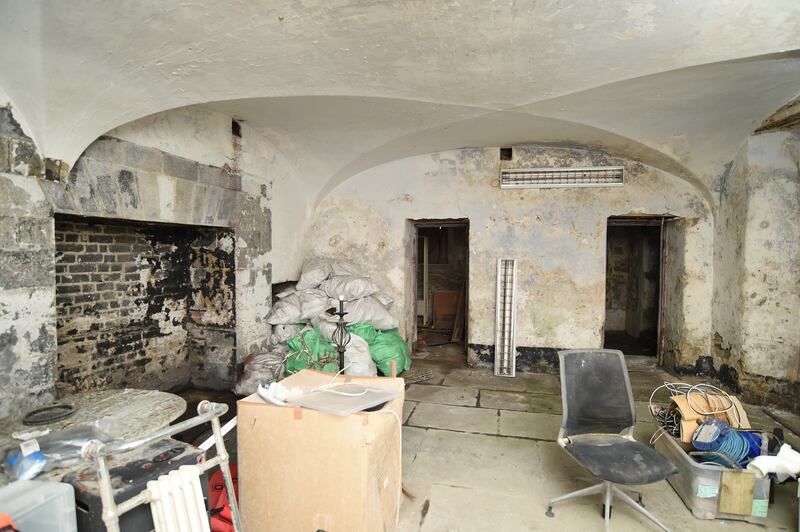Once the home of land agents and 1798 rebels, bankers and Christian Brothers, boarding school pupils and flat dwellers, Grove House in Westport is more Bridgerton than Downton Abbey these days.
The listed urban dwelling is also a fascinating monument to the vagaries of the history of the Co Mayo heritage town. Whether United Irishman and first lessee of the midtown property, John Gibbons, would approve of the contemporary concept of French Wwoofers is a matter of conjecture but they certainly helped owners Karen Whyte and Donnacha Curley in the first stage of the renovation of their home.
It was damp, derelict and water-damaged when they purchased fit or €117,500 in 2014. Before that, it had been purchased by a developer in the early 2000s building boom for conversion into high-end apartments. It was then repossessed by the bank during the financial crash and was left in a semi-derelict state without maintenance or securing of the site.



The couple’s family and friends thought they were a little crazy but were also excited and fully supportive of the huge challenge to save this great house.
READ MORE
“Nobody wanted it. It was in an awful state. That is why we got is so cheap. We were buying over 10,000 sq ft of house, including the basement, and 3,500 sq ft of an underground street and dungeons,” says Karen
However, cheapness has not been part of their lexicon since they started working on the 24-roomed, four-storey property, with over €600,000 spent to date, and an immeasurable amount to be yet invested in the restoration and renovation of the vast basement and exterior facade.
While Karen was the project manager for the renovation, her skills as an interior designer inspired her ideas for the transformation of this listed building into a 21st centre functioning property, a course she and Donnacha completed with the Irish Georgian Society helped to clarify the challenges they would face.
“We also learned a lot from our conservation architect, Peter Cox, and our brilliant builder, Padraig O’Malley. His brother, George, is a master craftsman in restoring old buildings and it was so interesting to learn from him. Basically, we learned to let the building dictate what we should do rather than change it completely,” says Karen.
It was invaluable too that Donnacha, who works as a patent attorney, happens to be a qualified electrical and electronics engineer.
“Donnacha focuses on how things work and I like to focus on how they look by innovating, creating and up-cycling,” she explains.



Take, for example, her use of the mannequins from her former boutique, The Whyte House, which was located just across the road from Grove House.
“It was just a bit of fun, my artist friend and I sprayed it in gold and we drilled up through it and put in a lamp on the top. I had a large collection of feathers and picked out the ostrich ones and glued them on to an old shade.”
Certainly, Karen’s quirky artistic eye, flourishes of bold colours and soft fabrics, define the ambience of the house now, but it was also her hard grafting, alongside Donnacha — scraping and skimming, scrubbing and painting — that has ensured absolute respect for the retention and restoration of the many Georgian and Victorian features.
Interestingly, two big factors significantly influenced the couple’s timeline for the completion of the project: inclusion in the 2020 series of RTÉ’s Great Ouse Revival series and the Covid lockdowns.
By the time they became involved with the television series, they had already restored and transformed the attic, allowing Karen to live full-time on the building site, with Donnacha joining her at the weekends.
A zoned-mains gas heating system was installed with future plans for a more energy-efficient heating and electrical system.
They had also restored or replaced the 56 windows, including the huge one that now frames a grand piano in the ballroom.
“An analysis by our window restoration expert revealed they spanned several different eras from the 1780s to the late 1900s, with some PVC windows a recent addition. We saved and restored every window we could, and Melletts of Ballinrobe handmade copies of the ones we couldn’t restore,” she says.
As well as the ballroom, it was then time to tackle hallways and stairs, the kitchen and the bar, the landings and the bedrooms.



Unsurprisingly, Karen and Donnacha were exhausted after the exigencies of those winter months, albeit really grateful to the group of Wwoofers who helped them over a three-week period.
Wwoofers are volunteers who are part of the Worldwide Opportunities on Organic Farms (WWOF), which is also a movement facilitating cultural exchange. They work in exchange for bed and board whilst becoming immersed in the culture and language. The young French men had become really passionate about the project.
The arrival of a pandemic-imposed lockdown then was not entirely unwelcome.
“Never, in our wildest dreams did we foresee the pandemic coming so soon after the initial restoration phase. To be perfectly honest, we were so exhausted, physically, mentally and financially, it was almost a “sign” from above to stop, and take some time out,” she says.
Moreover, she observes, they were so burnt out for the first few months of 2020 they “actually lost interest in the place” and couldn’t even appreciate all the hard work they had completed.
Respite and the enforced deceleration imposed by Covid lockdowns allowed them soon realise that the pressures of the television programme had, in fact, ensured they were significantly in advance of their 10-year plan.
“After a couple of months in lockdown, with Donnacha now working remotely full time from Westport, we slowly regained interest in getting the rooms not completed for the television programme into order. Obviously, there were no construction workers available, so we set to work decorating with whatever paints and materials we had to hand, or could source. Five bedrooms were completed and decorated with several generous furniture donations from people spring-cleaning their homes during the pandemic. I restored and up-cycled some of the donated items to suit each room. The house inside is now pretty much complete,” she says.
Naturally, there had been some interesting discoveries along the way.
“When trying to open up shutters that were pasted with layers of paint to the walls, we discovered some of what could be described as “graffiti style” pencilled journal writing. They included names and dates of people in the house, and what activities were happening on the day,” says Karen. “A fabulous local artist and schoolfriend, Mags Duffy, took copies of these and made a unique oil painting based on them for the house. Coincidentally, she had in her possession, an original roll book for the house when it was used as a technical school in the late 1800s and early 1900s.”
As the couple prepares for the next phase of the project, the fallout from the pandemic continues to have an impact with spiralling costs for building materials challenging their budget. Eight years ago when they first purchased the property, it took family members a whole weekend to dig out the overgrowth to even gain access.
“Wow! Was it worth it. The basement is the true treasure of the house. In addition to a full split level floor which encompassed the main kitchen and auxiliary pantries, there were storerooms and housekeeping accommodation. There is also an underground passage with overhead lighting and six dungeons, one of which contained a large well. We had it tested by the EPA and it has excellent water., and another contains a trough, so we assume it was used for animals.”

Now, the next big challenge is renovating the basement and underground dungeons and passage, and the couple hopes to complete the final phase involving external works by 2027.
Back upstairs, plans are already afoot to host a small number of this winter’s Westival events in the ballroom, while the couple also hopes to hose other cultural, social and charity events.
An obvious story that may in the future be interpreted by the strong local artistic community is the poignant realignment of the house in the early 1800s by banker George Glendenning, the second owner. He turned its back to the street so that its grand front faced the steep hill where his young daughter fatally fell off her horse.
If the walls could talk.
Advice from the experts
Renovating a historic building is not for the faint-hearted — and will need significant input from experts if the conservation is to be carried out in a sympathetic and appropriate manner.
Indeed Dr Fidelma Mullane, a vernacular building conservation specialist, says anyone planning such a project should talk to a specialist conservation adviser before the commencement of work.
In her view, the best approach to building conservation is one of minimum intervention — “intervene as little as possible and only where necessary”, and where possible, “repair rather than replace”.
Peter Cox, managing director of Carrig Conservation, was consultant for the Grove House project. One of the big challenges identified during the project was the large double-height bay window, which was structural, which meant that repairing it was challenging.
“However, working with a recognised conservation structural engineer we were able to achieve this with minimal damage or loss of original fabric,” he says.
Many of the internal decorative plaster ceilings were also hanging on by a thread, and the pinning and securing of this was carried out by an experienced conservation plasterer.
Insulating a period home is also that bit trickier; Cox says they chose Wood Fibre Board at Grove House, as the material is natural, permeable, and yet has high thermal efficiencies.
“Using natural materials to insulate the attic was also important whilst securing pathways within the attic for heating, ventilation and wiring so subsequent works would not damage or displace the attic insulation.
In addition to a conservation adviser, help can also be found at your local authority; as Mullane notes, most have a conservation officer who can provide advice and, case dependent, grant support for the conservation of historic buildings, particularly for those buildings on the Record of Protected Structures (RPS).
Similarly, conservation grants are available from heritage agencies such as the Heritage Council, and the Irish Georgian Society.
While the SEAI has grants available, as Cox notes, these unfortunately are not yet targeted at traditional or heritage buildings.

















